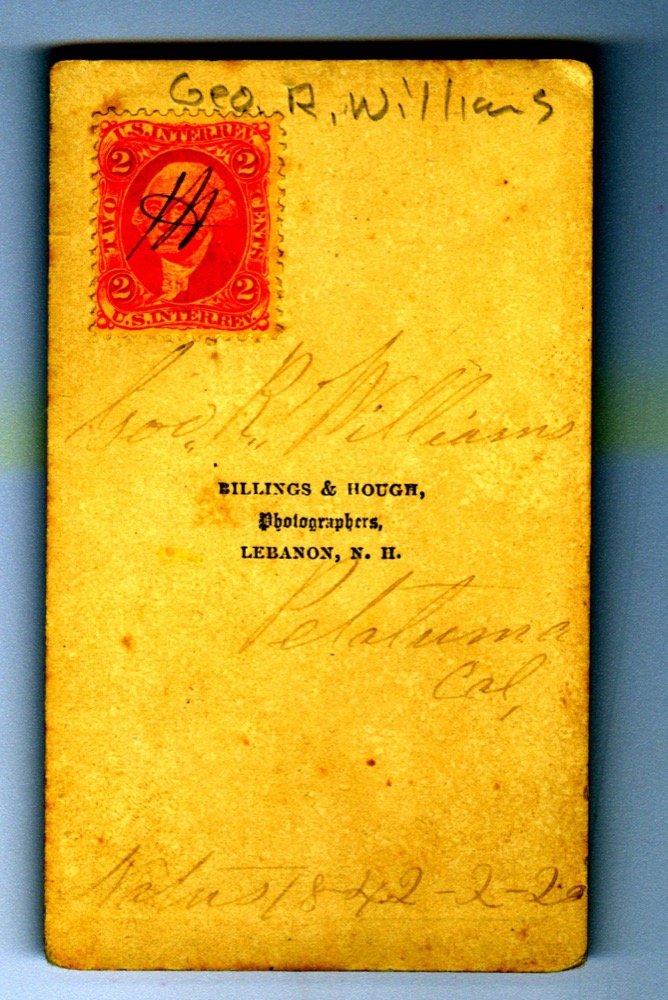Williams, Mehitable (Mehetabel) Lilly (1807-1899) (1 of 3)
/BRADLEY & RULOFSON’s STUDIO portrait of MEHITABLE LILLY WILLIAMS
THE PHOTOGRAPHER/ PHOTOGRAPHIC STUDIO:
Bradley & Rulofson, 429 Montgomery Street, San Francisco, California. Henry William Bradley (1813-1891) opened a photographic studio in San Francisco in 1850 and in 1860 took on his partner William Rulofson (1826-1876). Their studio was considered by many to be the best in California. Bradley retired in 1878.
THE SITTER:
Name: Mehitable Lilly Williams
Description:
Biographical Note: George and Mehetabel Williams were stellar examples of the pioneer spirit of hard work and determination. After testing his luck searching for gold, George sailed up the Petaluma River in 1851 in search for a location to build a family home, and in 1855 he convinced his wife and children to join him. In a strange twist of fate, Mehetabel and the children journeyed west while George was journeying east to fetch them. They eventually rendezvoused in Petaluma in August of 1855.
George was an enterprising developer and community builder. He constructed two of Petaluma’s earliest hotels, the American Hotel in 1852 and the Washington Hotel in 1856, and he was instrumental in constructing one of Petaluma’s first public schools and many of its private homes.
The full story of the adventures of George and Mehetabel is long and intriguing. Portions of their story are recounted in the memoirs of their son, George Roscoe Williams, and a thorough discussion is provided in Adair Lara’s definitive History of Petaluma, A California River Town. Adair Lara succinctly summed up George Williams’ legacy when she wrote, “It is ironic that Williams is remembered most in Petaluma history not for his ambitious hotel schemes, his land dealings, or his civic contributions, but for that idle moment early in 1856 when, out of longing to see his daughter again, or perhaps simply on impulse, he drew a rough sketch of Petaluma Creek and sent it off to John A. McNear, a young cousin who had married his daughter, Clara… In that moment, he changed Petaluma forever.”
George and Mehitable celebrated their 63rd wedding anniversary in November of 1898. They both died in 1899 and were buried in Petaluma’s Cypress Hill Memorial Park.
Family Affiliation: George Bailey Williams’ mother was Elizabeth “Betsy” Bailey Williams (1792-1882). His wife was Mehitable (Mehetabel)Lilly Williams (1807-1899), and his children were: Clarinda Damsen Williams McNear (1837-1866), George Roscoe Williams (1839-1934), Rosetta Lilly Williams Weeks (1842-1899), and Laura J. Williams Barstow (1842-1904).
Bibliography:
THE PHOTOGRAPH:
Format / Size: carte de visite
Medium: albumen photographic print mounted on cardstock
Description, front:
Description, back: Hugh Anderson’s imprint is on the center of the back of this carte de visite. Anderson created several versions of his Petaluma imprint. An expanded, possibly later, version appears here. It is printed in red ink and includes four lines of text, each in a different font. The text is embellished above and below with a horizontally flipped, elaborate flourish.
Date:
Condition:
Owner: The James Allen Family Collection, digital copy by permission.
Reproduction rights: The Petaluma Museum Association makes no assertions as to ownership of any original copyrights to the digitized images here reproduced. These images are intended for personal or research use only. Any other kind of use, including, but not limited to commercial or scholarly publication in any medium or format, public exhibition, or use online or in a web site, may be subject to additional restrictions including but not limited to the copyrights held by parties other than the Association. USERS ARE SOLELY RESPONSIBLE for determining the existence of such rights and for obtaining any permissions and/or paying associated fees necessary for the proposed use.




